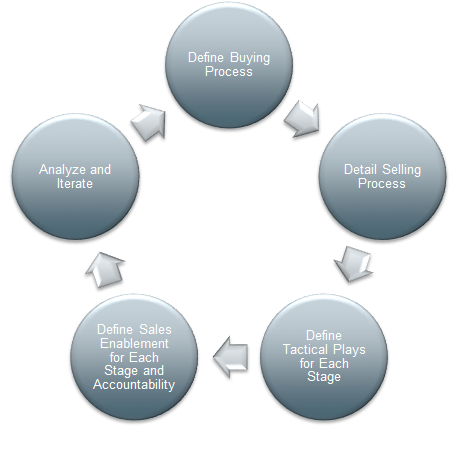
Professor Barhoum's Approach to Sales Playbook Design
- Define your buyers and their buying process
The biggest red-flag I’ve seen sales managers and leaders is their insistence on implementing the process that works for them. Hold-up! Your sales process is not buyer agnostic. The sales process must be built to support the buyer’s buying process. A buying process is both psychological and emotional. The psychological aspect maps to your selling process. The emotional aspect maps to your sales methodology.
To define our buyers and their buying cycle, we interview buyers to understand what would qualify them as an ideal customer. We want to learn their budget, buying methodology, decision-making process, need definition, where they conduct research, and when they buy.
- Ask your buyers of the steps they take throughout their buying lifecycle.
- Create a step-by-step journey of that buying process
- Think holistically: it is not just about you and your company.
- Detail the selling process
Now that we have the buying process defined, we create a detailed sales process that maps to the buying process. The sales process is a road map to closing business. It’s used for salespeople to understand their pipeline and future commits. It also communicates to management what can be expected for revenue and bookings, which is ultimately used for decision making. To accomplish this:
- Start with the following template and massage against the buying process:
- Profile
- Prospect
- Gain access
- Discovery/intake
- Test Drive/Walkthrough/POC/Vision Presentation
- Propose
- Negotiate
- Close
- Service
- Make it simple and easy to follow
- Define each stage so that particular requirements must be in place before the opportunity can move to the next stage.
- Define tactical sales plays for each stage
For each stage in your sales process, there are a set of plays that a salesperson can leverage to ensure the buyer exhaustively navigates the mapped stage of the buying process. Upon which the salesperson can help walk the buyer to the next stage in their buying process. When developing sales plays, make sure you:
- Develop a sales playbook where these plays live, with examples. These plays will change over time.
- Interview your sales reps to learn which sales plays have worked best. Often times these plays are tribal knowledge.
- Finally, train reps on these plays, using the sales process as a backdrop for individual plays.
- Define Sales Enablement for each step of the process and define accountability
The salespeople who make up your team are likely to be of relatively diverse backgrounds. Consequently, they will use their experiences, success and failures to personalize your sales process. This is great! But risky to the customer experience, your brand, and strength of the sales forecast. We implement a sales enablement program that address the sellers, the stages in the sales process, and the technology that helps to provide that enablement:
- People – Train on each stage, often. Practice the sales plays and create regular opportunities for booking and revenue commits, such as weekly roll call meetings and quarterly business reviews.
- Process – Develop guides to leverage the sales tools such as STEWD and how to Follow Up.
- Technology – Customer Relationship Management (CRM) platforms help capture key performance indicators (KPIs), which are used for forecasting and identifying salespeople who are under and overperforming.
- Analyze and iterate
Never stop listening to your customers, competitors, and employees. Capturing the right data is critical to informing your sales process and ensuring your company does not fall behind the competition. Partner with your marketing department to listen to the voice of the customer and take a close look at the relevance of your sales process annually.
